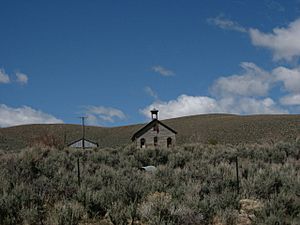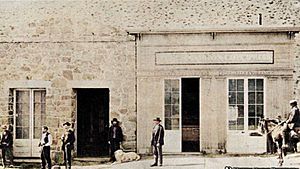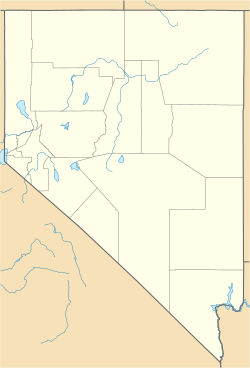Unionville, Nevada facts for kids
Quick facts for kids
Unionville, Nevada
|
|
|---|---|
|
Unincorporated community
|
|

Unionville, 2007
|
|
| Country | United States |
| State | Nevada |
| District | Pershing County |
| Area | |
| • Total | 0.77 sq mi (2.01 km2) |
| • Land | 0.77 sq mi (2.01 km2) |
| • Water | 0.00 sq mi (0.00 km2) |
| Elevation | 5,050.03 ft (1,539.25 m) |
| Population
(2020)
|
|
| • Total | 27 |
| • Density | 34.88/sq mi (13.46/km2) |
| Time zone | UTC-8 (Pacific) |
| • Summer (DST) | UTC-7 (PDT) |
| FIPS code | 32-76400 |
| Reference #: | 145 |

Unionville is a small community in Pershing County, Nevada. It is located south of I-80 and west of State Route 400. In 2020, only 27 people lived there.
Unionville was once a busy mining town in the 1870s. People came to find silver in the nearby hills. For a short time, the famous writer Samuel Langhorne Clemens, also known as Mark Twain, lived here. He tried to find silver but was not very successful.
Today, Unionville is a quiet place. It has one business, a tourist inn, and a few houses. These buildings are along a gravel road. The nearest paved road is about 7 miles away. If you need other services, like a store or gas station, they are about an hour's drive away.
Contents
History of Unionville
Unionville was founded in July 1861. It was the first county seat for Humboldt County. A county seat is the main town where the government offices are. Unionville served as the county seat until 1873. Then, the county seat moved to Winnemucca.
Mining Boom and Decline
The biggest mining boom in Unionville happened between 1863 and 1870. During this time, the town's population grew to about 1,500 people. Mark Twain arrived in Unionville in 1862. He came hoping to find silver. He described the town as having "eleven cabins and a liberty-pole."
Like many mining towns, Unionville started to decline after the boom. By 1870, people realized there wasn't much valuable ore left. The completion of the Central Pacific Railroad also sped up the decline. This railroad went through the Humboldt valley. It made Winnemucca a major center for trade and shipping.
Unionville Today
Today, Unionville does not have a formal local government. It is an unincorporated community. Some old buildings still stand, like what is believed to be Mark Twain's cabin. There is also an old one-room schoolhouse. These buildings are falling apart, and no one is actively working to save them. Because of this, Unionville is often called a ghost town.
Just north of the town, there is a cemetery. It might still be used for burials sometimes.
Population and People
| Historical population | |||
|---|---|---|---|
| Census | Pop. | %± | |
| 2020 | 27 | — | |
| U.S. Decennial Census | |||
Notable Residents
Paul Laveaga was an important person in Unionville's history. He was born in Mexico in 1841. He came to Nevada in 1866 and worked as a miner in Unionville. In 1868, Paul opened a lodging house and restaurant. He ran it until 1884.
Paul Laveaga also served as the postmaster in Unionville for many years. He was a successful businessman and well-respected. In 1874, he was elected to the state assembly. He served four terms there. He also worked as the Humboldt county treasurer for eight years. Paul Laveaga later moved to Winnemucca, but his success in Nevada started in Unionville.
Chinese Miners in Unionville
Like other mining towns, Unionville had Chinese laborers. They came to work in the mines in the American Canyon. However, some white residents in Unionville did not welcome the Chinese.
In January 1869, a group of people called the Anti-Chinese League forced the Chinese population to leave. About 35 Chinese men were put on a wagon. They were taken 25 miles away to Mill City. This was the nearest train station. The Chinese miners did not fight back. No one in the town tried to stop this from happening.
This event shows how some white people in Nevada felt about the Chinese at that time. Similar events happened in other communities across Nevada and the American West.
Even after this event, some Chinese miners returned to the area. After Unionville's mining declined for white miners, some Chinese came back to mine. They used special tools called rockers to find gold. This was because water was scarce in the area. By 1905, there were still a few elderly Chinese miners working in the American Canyon.
See also
 In Spanish: Unionville (Nevada) para niños
In Spanish: Unionville (Nevada) para niños



